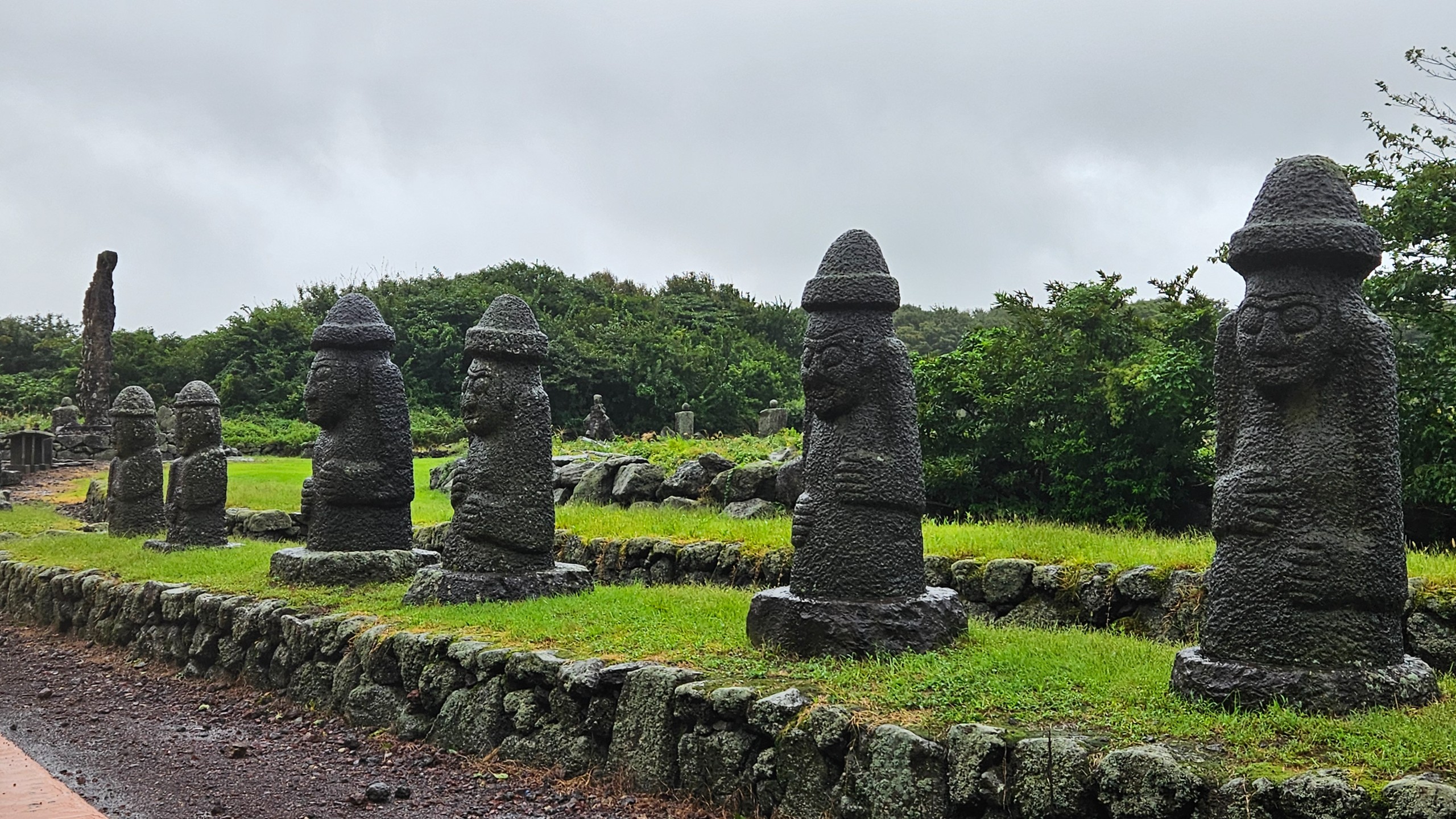
DAY 5
(Reading time: 7 minutes)
Never trust the weather on Jeju! The island is influenced by climatic conditions of mainland Korea, Japan, and China (if you’ve read The Three-Body Problem, you’ll understand perfectly), so practically anything can happen throughout the day.
The first warning sign came when the meteorological radar showed a perfectly clear sky in the morning, yet outside, dark clouds were already crying over that blatant lie. Wise solution is to follow a well-known saying “forewarned is forearmed”, and always have a raincoat, windbreaker, sunscreen, and some spare clothes (both heat and rain often have the same “soaking effect”) packed in your backpack.
Equipped as such, we headed from our hotel to one of the island’s most intriguing attractions – Jeju Stone Park. The first bus took us to the airport, where we used rather long transfer time to grab a meal of Japanese tonkatsu, rice, and udon noodle soup. It wasn’t quite lunchtime yet, but we didn’t want to risk being stuck later in some godforsaken wilderness with nothing warm to eat.
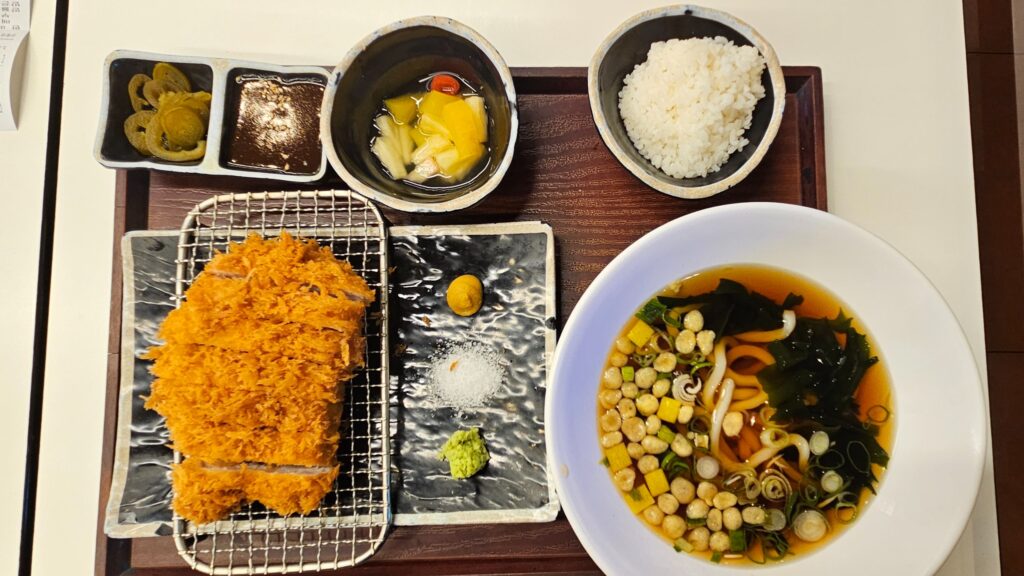
After about 40 minutes on an almost empty express bus (#131), we arrived at Jeju Stone Park. By then, it was raining so hard that an umbrella was more of a burden than a help, so we put on our raincoats. Just over our t-shirts, though, as it was still warm even in the rain.
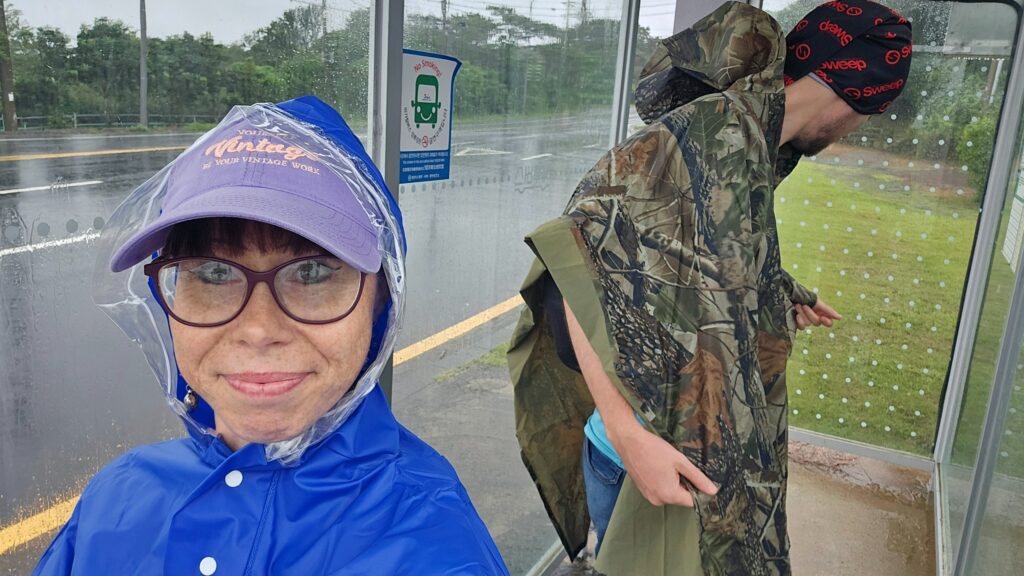
Jeju Stone Park is a sprawling museum, mostly outdoors, that combines scientific and mythological perspectives on the island’s origins. The scientific focus is found primarily in the stone building of the geological museum, while the mythology is “narrated” by motionless guardians of the island scattered along the outdoor paths.

One park, three zones:
– ORANGE Mythological Trail
– RED Historical Trail through the mysterious “gotjawal” forest
– BLUE Trail exploring traditional crafts and rural life
The complex also includes seven parking lots, an indoor museum, a multipurpose exhibition hall, a café, and a souvenir shop. Entry costs 5,000 KRW, and on average, you can spend about three hours walking outdoors. If you’re interested in geology, a visit to the museum can take additional two hours.
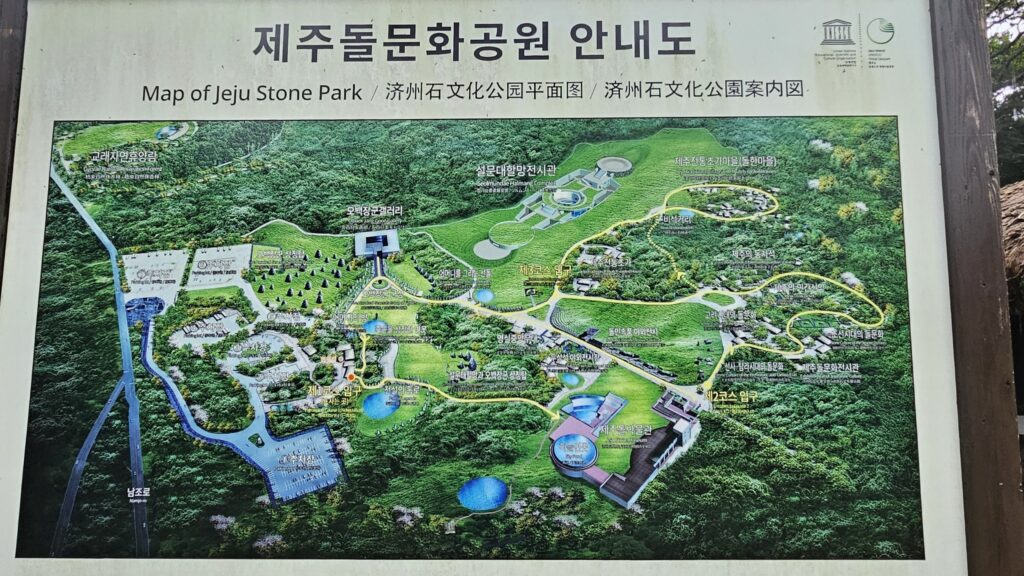
At the time, the seven spacious parking lots were completely empty due to the weather. But just as we reached the entrance, a bus full of tourists with yellow umbrellas pulled up. What are the odds? They caused a jam at the ticket counter and clogged up the first path, but after that, we never saw them again. Judging by their absolutely inappropriate attire (fit for a sunny day in the city), it was clear their bus driver’s break wouldn’t last long.
The largest and most popular loop, marked in orange, introduces visitors to the mythological figure of Seolmundae Halmang, the creator of Jeju Island. Legend says she was so gigantic that no ocean depth reached higher than her knees. According to the myth, she gave birth to 500 sons (generals). One day, while her sons went hunting, she prepared soup for them in an enormous pot. Tragically, she fell into the pot and drowned. Her sons came home hungry and ate the soup, including their mother.
The youngest son arrived late, noticed bones in the soup, and revealed the truth to the others. Heartbroken by the tragedy, the sons turned to stone, and their statues still stand there today. True story.
Sky Pond is a man-made water feature designed to resemble the pot of soup where Seolmundae Halmang died. The water is about calf-deep, and visitors can borrow practical rubber boots to walk in the “soup pot” and snap some memories – all for the perfect photo, of course!

Beneath this water feature is the aforementioned geological museum. While geology isn’t exactly our cup of tea, we felt obligated to at least take a quick look. However, the air conditioning inside was so freezing that we happily returned to the warm rain outside.
Part of the mythological trail is lined with traditional “dol hareubang” statues made of lava stone. People believe these statues grant prosperity, protect against misfortune and evil spirits, and thus are often placed at gates, entrances, and doorways.
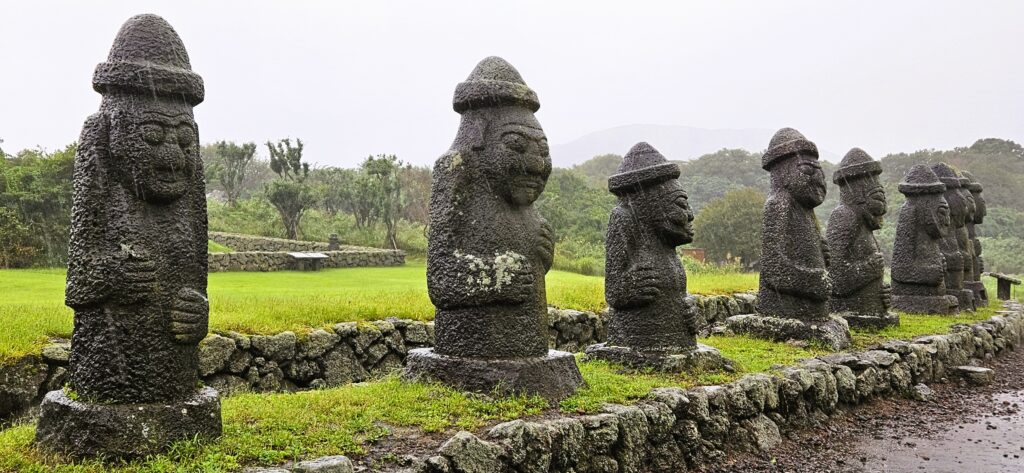
We found the red trail through the mysterious gotjawal forest more captivating. Gotjawal is a type of dense forest unique to Jeju, growing on volcanic substrate. It’s characterized by moss-covered rocks, exposed tree roots, and an abundance of ferns.
The forest was silent and almost motionless, with only the sound of raindrops attempting – mostly unsuccessfully – to break through the dense canopy above. Sheltered from the harsh weather, we walked along paths that passed by numerous burial mounds shaped like traditional Korean semi-circular tombs.
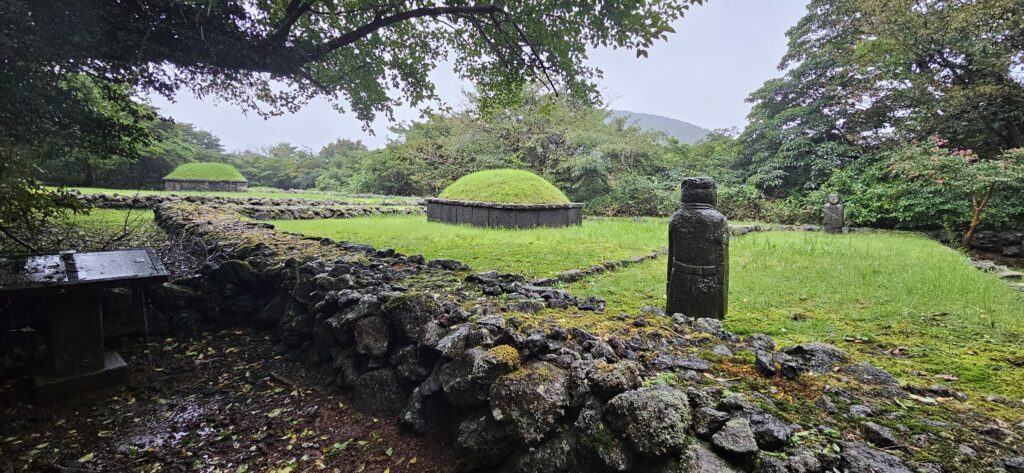
The graves are guarded by dongjaseok, small childlike stone statues placed in pairs nearby to protect and comfort the deceased’s soul.
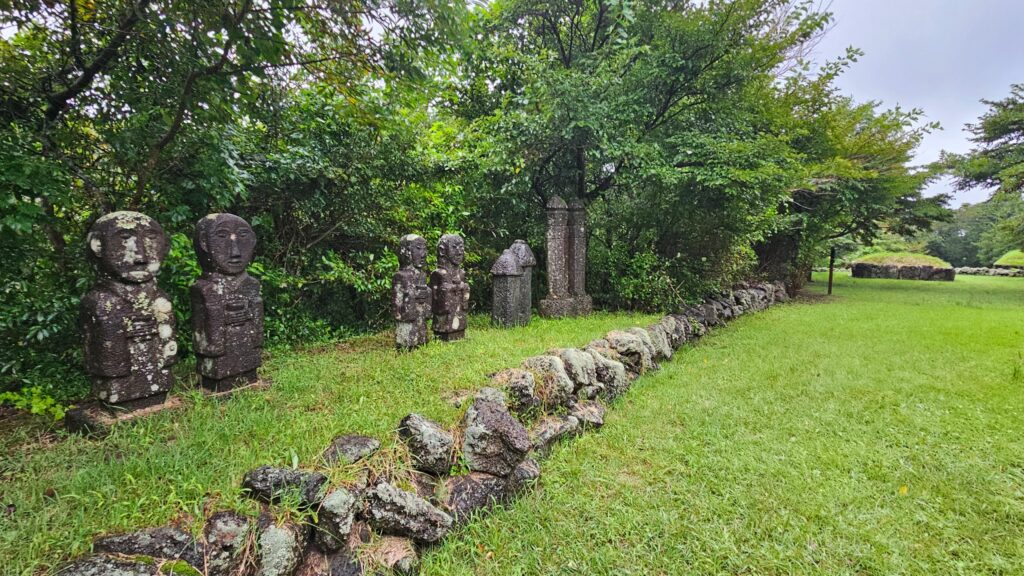
The greatest mystery of the gotjawal forest remains this scene:
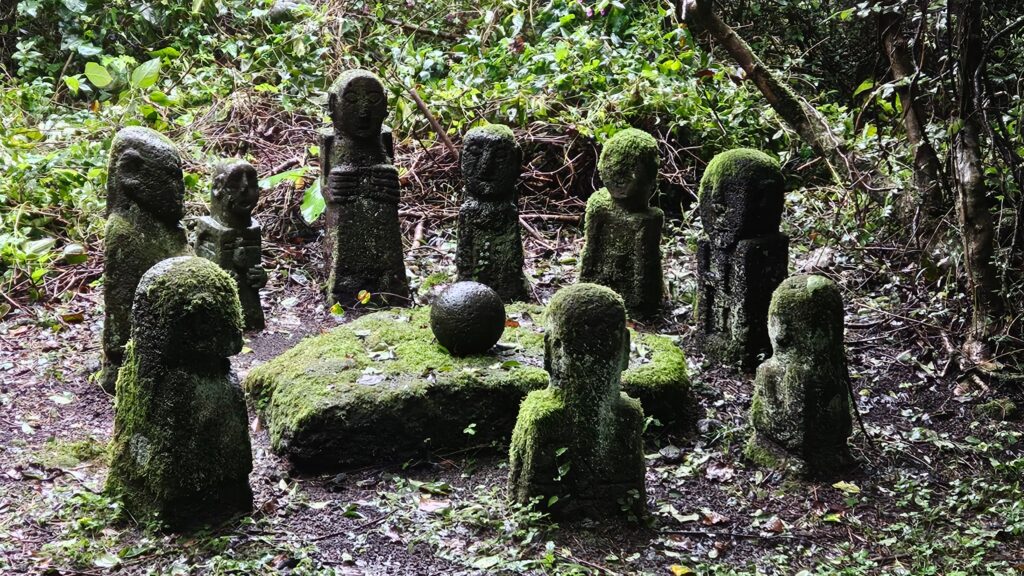
We didn’t make it to the final blue trail. Even with raincoats and waterproof hiking boots, prolonged exposure to the heavy rain was becoming too much. We also anticipated the challenge of getting back to the city. The traditional houses visible along the first two trails gave us a good sense of what we would have encountered anyway – only more intensely. Most of the houses were open and equipped with motion-activated exhibits showing items from daily life, such as kitchen utensils, tools, and clothing.
Returning by bus was exactly the kind of adventure you’d rather avoid.
The nearest bus stop had a functional display board. It showed that the next bus, the only one we didn’t need, would arrive in a few minutes and then again in 45 minutes. We would have preferred any one of the four other bus numbers, but they didn’t run, and we had no idea why. We decided to get on the next bus regardless of its number.
A tiny bus, seatings for only about ten people, arrived – empty except for the driver. Fortunately, he was friendly, and I managed to communicate with him in Korean to drop us off at the nearest intersection (“nearest” = about 5 km). Until then, he didn’t stop anywhere because no one was waiting at any of the stops.
Near the intersection, we found another stop, from which we took a bus heading to Jeju City Bus Terminal. From there, we switched to yet another bus and finally made it back to our part of the city. Phew… one bus there, three buses back.
As always, we rewarded ourselves for the effort with delicious food. We were craving Japanese curry, so we walked into a local Japanese bistro with a clear idea of what we wanted to order. The elderly lady running the place was quite insistent that we try their soba noodles and had a hard time accepting our refusal. We stuck to our plan, and our taste buds thanked us.

-endy-
DONKEY´S SPECIAL
-mj-